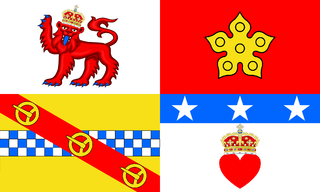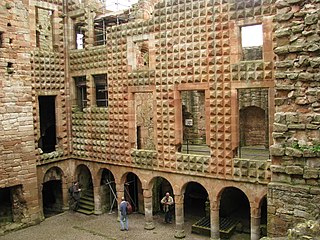
The Mormaer or Earl of Angus was the ruler of the medieval Scottish province of Angus. The title, in the Peerage of Scotland, is held by the Duke of Hamilton, and is used as a courtesy title for the eldest son of the Duke's eldest son.

Earl of Bothwell was a title that was created twice in the Peerage of Scotland. It was first created for Patrick Hepburn in 1488, and was forfeited in 1567. Subsequently, the earldom was re-created for the 4th Earl's nephew and heir of line, Francis Stewart, whose father was an illegitimate son of James V. The second creation was forfeited in 1612, and although the heir was subsequently rehabilitated, the title was never restored.

The Lord Warden of the Marches was an office in the governments of Scotland and England. The holders were responsible for the security of the border between the two nations, and often took part in military action. They were also responsible, along with Conservators of the Truce, for administering the special type of border law known as March law.

The Abbot and then Commendator of Melrose was the head of the monastic community of Melrose Abbey, in Melrose in the Borders region of Scotland. The abbots of the earlier Northumbrian foundation from Lindisfarne are not included here. The second abbey was founded in 1136 on the patronage of David I, King of Scots, by Cistercian monks from Rievaulx Abbey, Yorkshire. Control of the abbey was secularized in the 16th century and after the accession of James Stewart, the abbey was held by commendators. The last commendator, James Douglas of Lochleven, resigned the abbacy to William Douglas, 6th Earl of Morton in December 1606, and the abbey itself to the king in 1608. The abbey was then erected into a secular lordship for viscount Haddington, John Ramsay, who in 1609 was created "Lord Melrose". Lochleven however resumed the title of commendator in 1613 until his death in 1620.
The Abbot of Kelso was the head of the Tironensian monastic community at Kelso Abbey in the Scottish Borders. The Abbey was originally founded at Selkirk in 1113 by David, Prince of the Cumbrians, and thus the first three Abbots were Abbots of Selkirk. The community was moved to Kelso by David and John, Bishop of Glasgow in 1127. The abbot was the first in Scotland to be granted the mitre in 1165. In the 16th century the monastery increasingly came under secular control, and finally in 1607 it was granted as a secular lordship (Holydean) to its last commendator, Robert Ker of Cesford, later Earl of Roxburghe. The following is a list of abbots and commendators:

The Prior, then Abbot and then Commendator of Dunfermline was the head of the Benedictine monastic community of Dunfermline Abbey, Fife, Scotland. The abbey itself was founded in 1128 by King David I of Scotland, but was of earlier origin. King Máel Coluim mac Donnchada had founded a church there with the help of Benedictines from Canterbury. Monks had been sent there in the reign of Étgar mac Maíl Choluim and Anselm had sent a letter requesting that Étgar's brother and successor King Alaxandair mac Maíl Coluim protect these monks. By 1120, when Alaxandair sent a delegation to Canterbury to secure Eadmer for the bishopric of St Andrews, there is a Prior of the Dunfermline monks by the name of Peter leading the delegation. Control of the abbey was secularized in the 16th century and after the accession of James Stewart in 1500, the abbey was held by commendators. In the second half of the 16th century, the abbey's lands were being carved up into lordships and it was finally annexed to the crown in July, 1593.
The Prior of Loch Leven was the head of lands and of the community Augustinian canons of St Serf's Inch Priory, Loch Leven. There was a Scottish Céli Dé establishment there in the first half of the 12th century, allegedly found by Bruide, son of Dargart, King of the Picts (696–706). When the Augustinian priory was founded in 1150, the Scottish monks were absorbed into the established and those who refused to join were to be expelled. Not all of the priors are known. The most famous prior undoubtedly was the chronicler, Andrew de Wyntoun. Following more than four centuries of Augustinian monastic life and the resignation of the last prior, the Protestant king, James VI of Scotland, granted the priory to St Leonard's College, St Andrews.
The Abbot of Balmerino was the head of the Cistercian monastic community and lands of Balmerino Abbey, Fife, founded in 1227 x 1229 by monks from Melrose Abbey with the patronage of Ermengarde de Beaumont and King Alexander II of Scotland. The following are a list of abbots and commendators.
The Abbot of Holyrood was the head of the Augustinian monastic community of Holyrood Abbey, now in Edinburgh. The long history of the abbey came to a formal end in July 1606 when the parliament of Scotland turned the abbey into a secular lordship for the last commendator, John Bothwell. The following is a list of abbots and commendators:
The Prior of Urquhart was the head of the Benedictine monastic community of Urquhart Priory in Moray. The Priory of Urquhart was merged with the Priory of Pluscarden in 1454. The following is a list of priors and commendators: ___NOTOC___
The Abbot of Jedburgh was the head of the Augustinian canons of Jedburgh Abbey, Roxburghshire. It was founded by King David I of Scotland in 1138, and David's grandson and successor Máel Coluim IV ensured its promotion to the status of abbey before 1156. The position was secularized in the 16th century, and in 1606 turned into a secular lordship for the last commendator, Alexander Home, now earl of Home.
The Abbot of Lindores was the head of the Tironensian monastic community and lands of Lindores Abbey in Fife. The position was created when the abbey was founded some time between 1190 and 1191 by King William the Lion's brother Prince David, Earl of Huntingdon, and Lord of Garioch. The following is a list of abbots and commendators.
The Prior of May then Prior of Pittenweem was the religious superior of the Benedictine monks of Isle of May Priory, which later moved to the mainland became called Pittenweem Priory. The priory was originally based on the Isle of May, but was moved by 1318 to its nearby mainland site of Pittenweem, Fife, passing from the overlordship of Reading Abbey (Benedictine) to St Andrews Cathedral Priory (Augustinian). The following is a list of priors and commendators:
The Archdeacon of St Andrews was the head of the Archdeaconry of St Andrews, a subdivision of the Diocese of St Andrews, from the 12th to the 17th century. The position was one of the most important positions within the medieval Scottish church; because of his area's large population and high number of parish churches, the Archdeacon of St Andrews may have exercised more power than many Scottish bishops. The following is a list of known archdeacons:

Coldingham Priory was a house of Benedictine monks. It lies on the south-east coast of Scotland, in the village of Coldingham, Berwickshire. Coldingham Priory was founded in the reign of David I of Scotland, although his older brother and predecessor King Edgar of Scotland had granted the land of Coldingham to the Church of Durham in 1098, and a church was constructed by him and presented in 1100. The first prior of Coldingham is on record by the year 1147, although it is likely that the foundation was much earlier. The earlier monastery at Coldingham was founded by St Æbbe sometime c. AD 640. Although the monastery was largely destroyed by Oliver Cromwell in 1650, some remains of the priory exist, the choir of which forms the present parish church of Coldingham and is serviced by the Church of Scotland.
The Archdeacon of Glasgow was the head of the Archdeaconry of Glasgow, a sub-division of the Diocese of Glasgow. He was one of two archdeacons serving the Bishop of Glasgow, the other one being the Archdeacon of Teviotdale. This archdeacon (Glasgow) was responsible for region of the Diocese of Glasgow outside the Teviotdale region of the Scottish Borders region. The position was an important position within the medieval Scottish church, because of the high number of parish churches in the archdeaconry.
The Archdeacon of Dunblane was the only archdeacon in the Diocese of Dunblane, acting as a deputy of the Bishop of Dunblane. The first archdeacon, Andrew (Aindréas), was called "Archdeacon of Modhel" (Muthill); archdeacons Jonathan, Gilbert and Luke were styled "Archdeacon of Dunblane", while John and Duncan were called "Archdeacon of Strathearn". It is only from Augustine of Nottingham that the title settles at "of Dunblane". The following is a list of archdeacons:

Francis Stewart, 5th Earl of Bothwell, was Commendator of Kelso Abbey and Coldingham Priory, a Privy Counsellor and Lord High Admiral of Scotland. He was a notorious conspirator who led several uprisings against his first cousin, King James VI, all of which ultimately failed, and he died in poverty in Italy after being banished from Scotland. Francis's maternal uncle, the 4th Earl of Bothwell, was the chief suspect in the murder of James VI's father, Lord Darnley.
The Sheriff of Edinburgh was historically the royal official responsible for enforcing law and order and bringing criminals to justice in the shire of Edinburgh in Scotland. In 1482 the burgh of Edinburgh itself was given the right to appoint its own sheriff, and thereafter the sheriff of Edinburgh's authority applied in the area of Midlothian outside the city, whilst still being called the sheriff of Edinburgh. Prior to 1748 most sheriffdoms were held on a hereditary basis. From that date, following the Jacobite uprising of 1745, they were replaced by salaried sheriff-deputes, qualified advocates who were members of the Scottish Bar.

John Stewart, Commendator of Coldingham (1531–1563) was a Scottish landowner.






